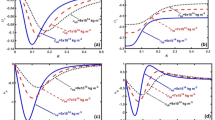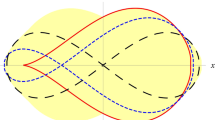Abstract
THE ‘free nutation’ of the Earth is a motion of the Earth's instantaneous axis of rotation around its mean position. The poles (intersections of the axis with the Earth's surface) describe changing orbits with the ‘Chandler period’ of about fourteen months. Every six or seven years the amplitude of these orbits reaches a maximum of up to ten metres and then decreases almost to zero. Following Jeffreys1, Bondi and Gold2 have considered that the free nutation has a characteristic damping time of the order of ten periods. They find that such heavy damping cannot arise from internal motion of the core or from relative motion between core and mantle, and conclude that it results from non-elastic behaviour of the mantle.
This is a preview of subscription content, access via your institution
Access options
Subscribe to this journal
Receive 51 print issues and online access
$199.00 per year
only $3.90 per issue
Buy this article
- Purchase on Springer Link
- Instant access to full article PDF
Prices may be subject to local taxes which are calculated during checkout
Similar content being viewed by others
References
Jeffreys, H., “The Earth”, 3rd edit., 210, 244 (1952).
Bondi, H., and Gold, T., Mon. Not. Roy. Astro. Soc., 115, 41 (1955).
Schweydar, W., Sitzungsber. Preuss. Akad. Wiss., 20, 357 (1919).
Gutenberg, B., “Internal Constitution of the Earth”, 2nd edit., 389 (1951).
Author information
Authors and Affiliations
Rights and permissions
About this article
Cite this article
GUTENBERG, B. Damping of the Earth's Free Nutation. Nature 177, 887–888 (1956). https://doi.org/10.1038/177887a0
Issue Date:
DOI: https://doi.org/10.1038/177887a0
Comments
By submitting a comment you agree to abide by our Terms and Community Guidelines. If you find something abusive or that does not comply with our terms or guidelines please flag it as inappropriate.



